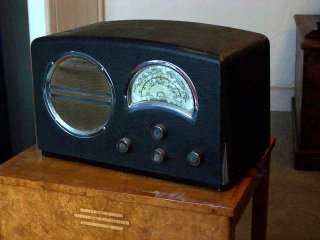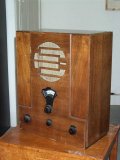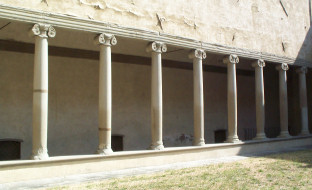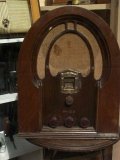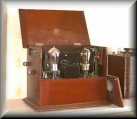Standard production
DEFINITION: (Term coined by Alan Beck)
| Most radio plays are directed and post-produced in this realist style. |
| We can hear the dialogue clearly. |
| There is a relatively neutral acoustic. |
| The perspective is organised around a fixed sound centre. |
| See further in REALISM - RADIO DRAMA TECHNIQUES OF REALISM |

|
|
|
|
|
|
|
|
|
|

|
This is conventional production style of most realist radio drama, once stereo technology was in place. There is much variety in production today. But a lot of radio plays are - rightly - in the style of "standard production". This rough-and-ready term (of mine) pays credit to the marvellous and entertaining values of such broadcast plays. It takes great skill (writing, directing, acting, technical) to get listeners to believe in such radio fictional worlds. Consider it this way, from film: The best compliment one can pay an editor is to tell him his editing is invisible: an editing job is considered successful when it goes unnoticed on the screen. Ironically, an editor invests weeks or months of intensive work to achieve the impression that he has done nothing at all. (Ephraim Katz, The Macmillan International Film Encyclopaedia)
Standard production offers quicker solutions to many technical problems, such as outside scenes, phone calls and sound perspective. It is the result of regular working practices, in long-established studios, with experienced staff. There is not a right or a wrong here for the radio drama director. Standard production is the 'right' choice for the style of many radio drama scenes, such as the realistic, in many domestic settings (sitting-room etc.). Furnishings and the size of rooms in most houses mean that, in the Lifeworld, we experience sounds and dialogue in a relatively 'neutral' acoustic. A lot of sound is absorbed by the soft textures. We concentrate on the dialogue. The background location sounds are balanced low against the dialogue - see Atmos bed (underneath the scene dialogue) - establishes scene location or scenery. We also filter out a lot of other sound events in the Lifeworld, so that even in a busy street, we foreground our talk with our friends. So there is not a 'right' or a 'wrong' for the director. There are artistic choices and the demands of production. Standard production is mostly confined to realism - it offers the most effective 'window on the world' for the radio drama director. Listeners can complain if they cannot hear the dialogue against the 'thumpy' sound effects. Balancing dialogue and effects is an expert skill.
I wish to credit all those plays I have labelled as standard production. This choice of an aesthetic suits the script, and a standard production play can show the deepest sensitivity, experience, and technical expertise. The filmic aesthetic will not suit most scripts. Extreme realism or hyper-realism ditto. MIXED REALISM: Some radio plays mix realist scenes with 'Dear Diary' or 'Dear Listeners' scenes, where the main character speaks directly as a narrator. This double structure has great strengths. See Narrator My definition here is rather loose. It is just a practical term for joining together features heard in most realist radio plays. To sum up: Most often the dialogue comes first, and second, with radio drama scripts. A director cannot just look for powerful sound effects to attach to a dialogue structure already in place.
MORE DETAILED DEFINITION AND YOU NEED TO LISTEN TO PLAYS AND IDENTIFY THIS RANGE OF REALIST STYLES: (1) Realism and neutral acoustic (or relatively neutral acoustic) There is limited use of acoustic - mostly the neutral acoustic (or relatively neutral). It is a relatively 'bare' form of production. Greater production detail is in evidence in genre plays (as thrillers, adventure novel adaptations (RL Stevenson), comedy) - not standard production. (2) Sound pictures are organised around one sound centre. (3) Perspective is usually close-up to mic. Usually in position three at the microphone (dialogue). (4) Standard production creates a conventional 'reading' of such plays (in the best, creative sense), an overall 'production solution' for the director. (5) Standard production shapes the narrative. (6) Standard production avoids other alternatives Alternatives - fresher, 'brighter', more 'natural' acoustics and sound pictures, film techniques (the 'filmic' radio drama directing style), radio expressionism, anti-realism, on location recording.
Academic work: This term is coined in parallel to Hollywood "classical narrative cinema" and Hollywood "classicism", established from the forties to the early sixties. The BBC is a production factory, a monopoly, on the model of Hollywood. The work of individual directors is scarcely to be differentiated one from another.
Notes for class discussion (1) Investigate further the details of standard production,
within this broad definition. Start with THE ARCHERS and with
Afternoon plays (BBC). (2) Here is an area where comparison with film is useful.
Especially if you have been working on a film course. This also
involves a taking-over of some concepts into the area of radio.
(3) What are the limits of radio realism? Film, with its visual
track, can bring its audiences into contact with life, particularly
in exterior settings and movement, far beyond the stage and indoor
studio. Allowing for the danger that it cannot be a slavish reproduction
of nature. (4) Hollywood was a dream factory - so is the BBC Radio Drama Department? (5) Standard production is comforting and it does not make the reader's (listener's) task problematic. (6) There is use of subjective camera in the Hitchcock film,
'Psycho', but note, by contrast, how little use is made (relatively)
of subjective mic in radio drama. See point of listening.
Further notes on Hollywood film classicism (academic) |
CONTINUING THROUGH THE SITE: Genre (academic) and types of plays
Styles of production, directing and post-production
|
|
Storyboard | |
|
|
|
|
|
|

To Index 'A' to 'Z' for this site - use to navigate
This site is 'Radio Drama - directing, acting, technical, learning & teaching, researching, styles, genres'. See INDEX to navigate also. Complete curriculum of scripts, techniques (acting & directing & post-production & genre styles), advice, sound files - effects and atmoses (with no copyright and so free to use), detailed script commentaries, etc.
TECHNIQUES - FULL RANGE OF RADIO DRAMA TECHNIQUES ON THESE SITES
Academic material on this site is
Alan Beck is licensed under a Creative Commons Attribution-Non-Commercial-Share Alike 2.0 UK: England & Wales License.
Learn about radio drama on this site along with my book - Beck, Alan, Radio Acting, London: A & C Black ISBN 0-7136-4631-4 Available on Amazon. CLICK HERE.
To the WELCOME PAGE for Alan Beck's sites. See more of Alan Beck's work.
Any opinions expressed in this site are the personal opinions of the owner of the site. IF YOU HAVE COMMENTS, PLEASE EMAIL TO : [email protected]
